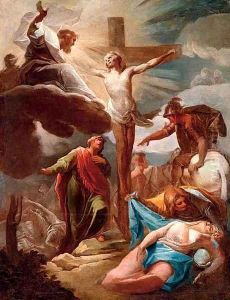Corrado Giaquinto Molfetta Paintings
Corrado Giaquinto was an Italian Rococo painter born in Molfetta, a small town in the region of Apulia, in 1703. He is recognized for his vibrant and elaborate religious and mythological compositions, which reflect the exuberant and decorative style that characterized the Rococo movement. Giaquinto's work is characterized by its dynamic compositions, lively colors, and a light, graceful touch that was typical of the period's aesthetic.
Giaquinto began his artistic training in Naples under the guidance of Nicola Maria Rossi where he was influenced by the Neapolitan Baroque movement. He later moved to Rome, which was a significant center for artistic development in the 18th century. In Rome, he worked under Sebastiano Conca and further developed his skills, becoming known for his frescoes and altar pieces in churches such as San Giovanni in Laterano and Santa Croce in Gerusalemme.
In 1753, Giaquinto was called to Spain by Ferdinand VI, and he became the court painter in Madrid. During his time in Spain, he received numerous commissions for religious and decorative works, including frescoes for the Royal Palace of Madrid and the church of San Francisco el Grande. His contributions to the artistic landscape in Spain were significant, and his work had a lasting impact on Spanish painting.
Giaquinto's work was celebrated for its artistic innovation, which combined the drama of the Baroque with the lighter, more decorative elements of the Rococo. His ability to convey movement and emotion through color and form was particularly notable. Despite his success, Giaquinto's work fell out of favor towards the end of the 18th century as neoclassicism became the dominant artistic style.
Corrado Giaquinto died in Naples in 1765. His legacy is preserved in the numerous works he left behind, many of which are housed in important art museums and collections around the world. Today, he is remembered as one of the leading figures of the Rococo movement in Italy and as an artist who helped to shape the visual culture of his time.
